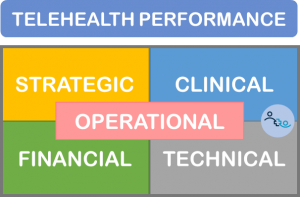Over the past 10 months I’ve written extensively about the shortcomings of poorly implemented telehealth: “The Top 4 Side Effects of poorly implemented telehealth”, “6 Ways Telehealth Failed in 2020”, and “3 Characteristics and 3 Root Causes of Mediocre Telehealth” are just three examples. So rather than lamenting poor performance again, let me share with you 6 smart moves for healthcare organizations to quickly optimize the performance of their telehealth services.
The 5 Domains of Telehealth Performance



At the core of a telehealth services’ performance are the operational measures which include the common metrics of number of services performed as well as satisfaction scores. Next are performance measures around the strategic alignment of the telehealth services. Most critical in many circumstances are the clinical outcome measures as well as the financial performance of a telehealth service. Both performance measures are key for a sustainable telehealth. Lastly the technical performance, often measured in helpdesk calls, can be evaluated.
1. Optimizing the Clinical Performance
Ultimately nothing counts more than ensuring the clinical care provided and received creates the desired clinical outcomes. With telehealth relatively new to many clinical teams, their experience with how to best leverage the technology is limited. A relatively easy to implement optimization is to bring all clinicians together to develop their own clinical telehealth guidelines. These can include guidelines on conducting exams or under what conditions certain modalities (in-person, video chat, telephonic) are clinically appropriate?
2. Optimizing Financial Performance
A close second when it comes to the improvement of telehealth performance is ensuring that organizations get paid appropriately for the care delivered. We thus recommend to periodically review telehealth billing practices and reimbursement levels to identify opportunities to maximize reimbursement and minimize write-offs. This includes for example delivering and billing at the highest possible level, eliminating the delivery of non-reimbursable services, etc.
3. Optimizing Operational Performance
Based on our experience of implementing dozens of telemedicine services, the keystone to a successful telemedicine service is the engagement of the clinicians (read: satisfaction) with well-designed workflows, appropriately-selected technology and knowledgeable, timely support. Secondary to that is the proper definition of all workflows from scheduling, pre-appointment TechChecks, and TeleRooming to post-visit activities and billing.
We therefore work with all of our clients to ensure that clinicians are adequately trained and supported clinicians and to initiate the implementation of proven approaches to achieve high physician satisfaction (see: “Making Telemedicine Enjoyable for Physicians”).
4. Patient Engagement & Marketing
“Build it and they will come” may have worked at the height of the Covid-19 health crisis, but as a sense of normalcy is setting in and as other healthcare providers are offering telehealth services, it is important to make sure that your patients are having a great experience and that they know about the services your organization is offering.
We therefore recommend that you study and develop patient telehealth engagement tactics, starting with the systematic identification of barriers to engagement (oftentimes: bad experience, privacy concerns or technophobia (see: “Telehealth visits are more secure, offer more privacy”), connectivity problems, etc.) and create a multiple marketing ideas (from “word of mouth” and Facebook ads to letters to the editor and optimizing your webpage).
5. Quality Improvement with Telehealth
The Q-word is thrown around in healthcare a lot and it definitely has its rightful place in telehealth, too.
Two quality optimization approaches come to mind: First, you want to leverage typical clinical quality metrics, such as Press-Ganey and HCAHPS scores, in addition to condition-specific health outcomes, such as post-surgical wound healing, A1C for diabetics, medication compliance, etc.
The second approach is to adapt a mindset of continuous quality improvement of the telehealth service. The basis for continuous improvement is to first put the proper measurement systems in place so that improvements can easily be measured. The common first steps include to establish a telehealth service performance dashboard; set targets for the key performance indicators; conduct root cause analysis on missed targets; design and implement interventions; and how to strategically leverage telehealth to improve the organization’s overall quality scores.
6. Expand into Remote Patient Monitoring (RPM)
This is not an optimization of a telehealth service, but really an optimization of your overall telehealth program. 2021 is definitely shaping up to be the year of remote patient monitoring. Whether it is for the close management of patients with multiple chronic care conditions, preventing readmissions or extending critical care into the home — the applications and uses for RPM are manifold and the potential for big ROIs is high.
To get started in RPM, first create your business case for each service and define with the clinical teams the desired workflow. before evaluation and selecting a vendor.
What Smart Optimization Moves have you Used?
What optimization have you completed in the past months to get the operational, financial, clinical, technical, and strategic performance of your telehealth services under control?
Let me know, I’d love to compare…








To receive articles like these in your Inbox every week, you can subscribe to Christian’s Telehealth Tuesday Newsletter.
Christian Milaster and his team optimize Telehealth Services for health systems and physician practices. Christian is the Founder and President of Ingenium Digital Health Advisors where he and his expert consortium partner with healthcare leaders to enable the delivery of extraordinary care.
Contact Christian by phone or text at 657-464-3648, via email, or video chat.







Leave A Comment